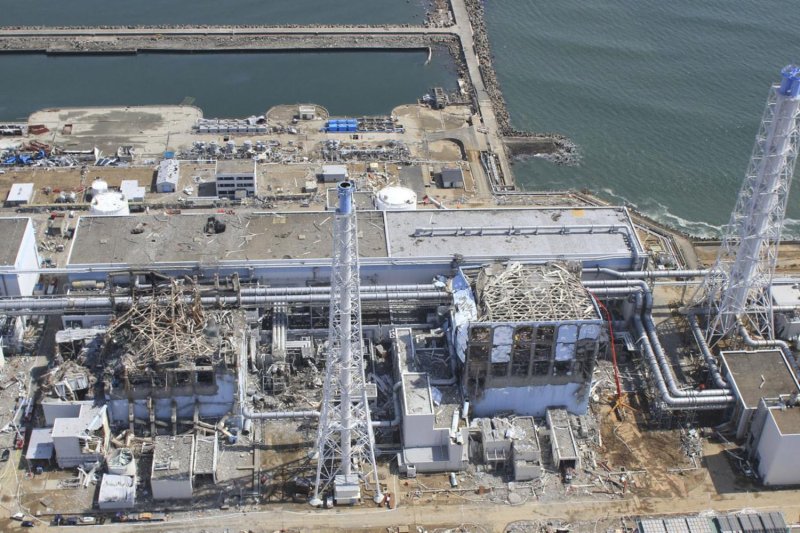The crippled Fukushima Dai-ichi nuclear power plant in Okumamachi, Fukushima prefecture, northern Japan is seen in this March 24, 2011 aerial photo taken by small unmanned drone and released by AIR PHOTO SERVICE. UPI/Air Photo Service Co. Ltd. |
License Photo
TOKYO, April 12 (UPI) -- Japanese officials raised the severity level at the crippled nuclear plant to the maximum level 7, the same as the world's worst nuclear disaster at Chernobyl.
The Nuclear and Industrial Safety Agency raised its evaluation based on an estimate radioactive materials exceeding the threshold for level 7 have been released into the environment, noting, however, the release from the Fukushima Daiichi plant was about 10 percent of that from the former Soviet nuclear plant, Kyodo News reported Tuesday.
Japan's regulatory agency and the Nuclear Safety Commission of Japan said 370,000 terabecquerels to 630,000 terabecquerels of radioactive materials have been emitted into the air from its Nos. 1, 2 and 3 reactors.
(A becquerel is the activity of a quantity of radioactive material in which one nucleus decays per second. One terabecquerel equals 1 trillion becquerels.)
Chief Cabinet Secretary Yukio Edano said the government is "sorry to Fukushima residents, the Japanese people and the international community" about the nuclear disaster triggered by the 9-magnitude March 11 quake and tsunami.
Plant operator Tokyo Electric Power Co. also apologized for being unable to stop the radiation leak, pointing to the possibility total emission of radioactive substances eventually may eclipse the 1986 Chernobyl incident.
A large amount of the radioactive materials emitted is thought to come from the plant's No. 2 reactor because its containment vessel's pressure suppression chamber was damaged by an explosion March 15, Kenkichi Hirose, of the safety commission, said during a news conference.
"Our estimates suggest the amount of radioactive materials released into the air sharply rose March 15 and 16 after abnormalities were detected at the No. 2 reactor," Hirose said. "The cumulative amount of leaked radiation has been gradually on the rise, but we believe the current emission level is significantly low."
Officials said it took about a month to upgrade the severity level because of a delay in getting reliable monitoring data, Kyodo reported. On March 18, the agency set the level at 5, the same as the 1979 Three Mile Island accident in the United States.
Hirose said a re-evaluation of the 12-mile evacuation zone would not be reviewed after raising the severity level.
Workers extinguished a fire that broke out in at reactor No. 4 at the Fukushima facility after a 6.3-magnitude aftershock struck Japan Tuesday, officials said. The quake did not trigger a tsunami warning.
Tokyo Electric said it had no further details, including what might have caused the blaze or where in the reactor it occurred..
The complex suffered a series of explosions after the earthquake and tsunami struck off the coast of northeast Japan March 11. Nearly 28,000 people are reported dead or missing.
Japanese Economics Minister Kaoru Yosano said Tuesday the disaster's economic damage likely would be more severe than originally estimated. Material damage alone could top $300 billion, the government said.















